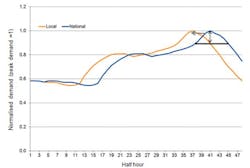The Potential Value of DSOs: Lowering Cost on a Flexible Grid
Decarbonization and technological advances are transforming our electricity system, driving growth in distributed energy resources (DERs) and making demand side response a more accessible and flexible energy resource. As we move toward a net-zero energy system, we are seeing two broad trends asserting themselves in the electricity sector: first, the demand for flexibility is on the rise as renewables are contributing more and more to the energy mix. Second, more of this flexibility will be located at lower voltage levels as the flexible, “on-demand” resource is provided by distributed generation and storage, electric vehicles (EVs) and smart heat solutions. In a recent study for the Energy Systems Catapult in the United Kingdom, AFRY analyzed how to efficiently and effectively manage this changing system in order to minimize operation costs.
Potential for rising costs
As electricity systems evolved, we found there is potential for electricity costs to rise for consumers as a result of a divergence in the timing of local and national electricity demand peaks which lead to an increased risk of an inefficient system (see Figure 1). In such a system, there will be more competition between the transmission and distribution (T&D) system operators for flexibility services which may only be operational for short time periods, for example, as batteries take time to recharge. Without effective coordination between transmission system operators (TSOs) and distribution system operators (DSOs), this divergence may increase overall network and generation investment requirements, generation costs and system balancing costs, ultimately increasing costs for consumers.
AFRY contrasted the effect of prioritizing the use of distributed flexibility resources to meet national peaks, local peaks and having a fully integrated system. Our outcomes showed that frameworks that enable a more coordinated use of resources could reduce system costs by up to 7 billion pounds (US$9.2 billion) by 2050.
When considering how best to manage new grid systems, we also found that the largest savings arise in frameworks where distributed flexibility sources are used primarily to address local network issues. This enables DSOs to avoid a greater level of costly network replacement and reinforcement as there are limited close alternative flexibility options at the distribution level.
Managing the transition
It’s clear that there are large potential savings to be had; it’s just a question of how to get there. Any new arrangements should transparently reveal and respond to the true value (and cost) of using flexibility on the T&D systems. A transition to a more decentralized energy system and active DSO model means fundamental changes in the roles and responsibilities of TSOs and DSOs, and the frequency and extent of information and data exchange between system operators and users to keep system costs down.
Such changes can be introduced gradually, reflecting the evolution in the TSO-DSO relationship over time.
In the short term, the transition should focus on establishing a framework where the TSO can coordinate more effectively between the needs of local DSOs and the national system, improving information flows from DSOs on the local effects of national actions. Then, in the longer term, wider changes, such as the emergence of local or regional flexibility markets, may emerge naturally as greater transparency and understanding of the value and accessibility of flexibility emerges.
Within this framework, it remains important to encourage more flexible resource use. Regulatory incentives should continue to encourage DSOs to consider innovative non-asset solutions to network issues. Harnessing the opportunities from electrification of heat and transport will be an important part of this innovation. For example, smart charging for EVs could help to manage increases in demand and will help to balance the grid.
All in all, a managed and considered shift toward a more coordinated T&D system, will ensure that we shield consumers from expensive and inefficient systems. By moving toward new models of interaction there is opportunity for significant savings, but we recommend a careful and phased shift in the roles and responsibilities for DSOs and TSOs.
For more details on the potential impact of DSOs, see the full report here.
About the Author

Gareth Davies
Gareth Davies is a director at AFRY Management Consulting with 23 years of experience advising on energy policy, regulation and market design across Europe.

David Cox
David Cox is a senior consultant at AFRY Management Consulting focusing on electricity network regulation and policy.

